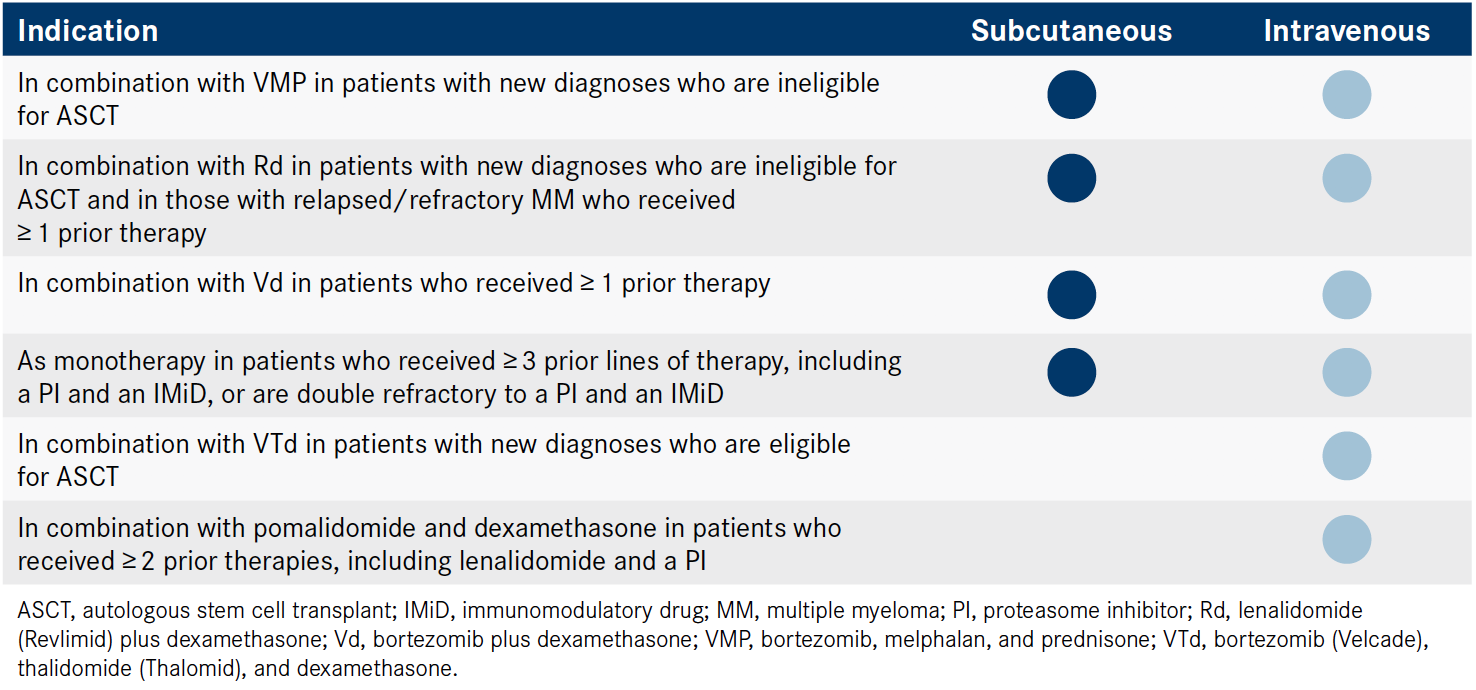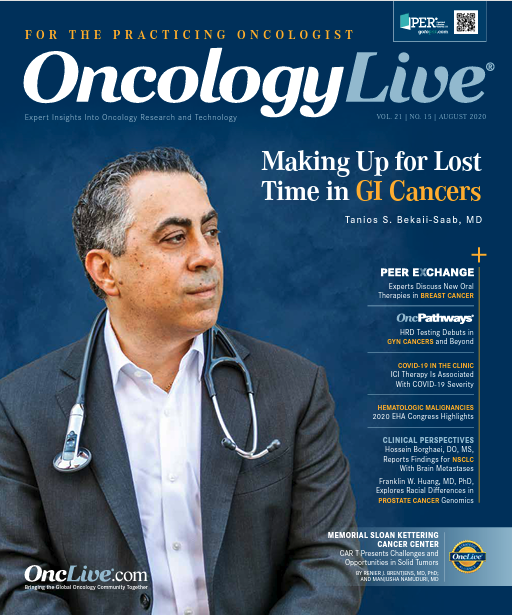Publication
Article
Oncology Live®
Subcutaneous Daratumumab Appears Primed to Transform Myeloma Care
Author(s):
A new subcutaneous formulation, daratumumab and hyaluronidase-fihj, provides similar efficacy in a more convenient and efficient regimen that is likely to change practice.
Ajai Chari, MD

Daratumumab (Darzalex) therapy has led to significant improvement in response rates and progression-free survival both in combination regimens and as monotherapy across several indications in patients with multiple myeloma.1 Now, a new subcutaneous formulation, daratumumab and hyaluronidase-fihj (Darzalex FasPro), provides similar efficacy in a more convenient and efficient regimen that is likely to change practice, according to experts.
Since its initial approval in 2015, the anti-CD38 monoclonal antibody has been administered as an intravenous (IV) injection.1 The FDA approved subcutaneous daratumumab on May 1, 2020, for adults with newly diagnosed or relapsed/refractory myeloma based on results from the phase 3 COLUMBA trial (NCT03277105), with supporting data from the phase 2 PLEIADES trial (NCT03412565) (Table).2
Table. FDA-Approved Indications for Daratumumab1,2

COLUMBA randomized 263 patients to subcutaneous daratumumab and 259 to IV daratumumab. The overall response rate for the subcutaneous dosing was 41.1% versus 37.1% with the IV formulation (ratio of response rates, 1.1; 95% CI, 0.89-1.37). A comparison of the pharmacokinetics showed that the geometric mean trough concentration ratio of subcutaneous to IV daratumumab was 108% (90% CI, 96%-122%) and maximum levels before cycle 3 were similar or higher.3
The investigators concluded that subcutaneous daratumumab was noninferior to the IV formulation for response rate and pharmacokinetics, the 2 primary end points of the study.
As part of a recent OncLive® Insights program, Ajai Chari, MD, an expert in plasma cell disorders, discussed the clinical and practical implications of the new formation with Daniel J. Verina, MSN, RN, ACNP-BC, a nurse practitioner who specializes in multiple myeloma.
Chari is director of clinical research of the multiple myeloma program; associate director of clinical research in the Cancer Clinical Trials Office; and professor of medicine, hematology/ oncology at the Icahn School of Medicine at Mount Sinai in New York, New York. Verina is part of the myeloma team at Mount Sinai.
Improving IV Administration of Monoclonal Antibodies
Although IV daratumumab has led to better outcomes for many patients with multiple myeloma, Chari described hurdles to administering the infusions. “From a practice management point of view, one of the biggest barriers to getting daratumumab has been that first dose issue, that long infusion, the 1-on-1 nursing staffing, the chair time. All of those barriers, I think, are challenging,” Chari said.
There was a striking difference in the duration of administration between the 2 formulations in the COLUMBA trial, Chari said. “In this study, obviously one of the most important and interesting findings is that the median duration of infusion in the first administration was 421 minutes for the IV versus 5 minutes for the subcutaneous [infusion]. And that [extended through the trial with] 255 minutes versus 5 minutes for the second dose and 205 minutes for the remaining course versus 5 minutes. So, we’re looking at 7, 4, and a little over 3 hours for the IV, whereas the subcutaneous regimen remains flat at 5 minutes,” he said.
Chari called the subcutaneous administration “a great liberation from the infusion center.”
The recommended dosage of the new formulation is 1800 mg of daratumumab and 30,000 U of hyaluronidase administered subcutaneously into the abdomen over approximately 3 to 5 minutes.2 “I think on the whole, it’s going to revolutionize how patients are treated,” Verina said. “I think it is safe to give, the efficacy is there, and the adverse events [AEs] and infusion-related events are extremely low compared with the intravenous [administration]. I feel that it’s a great option [for] patients, and if there’s a community physician who can give this drug instead of the patient driving 2 hours in each direction, it’s also saving them the wear and tear, even emotionally, of driving to the institution.”
Infusion-Related Reactions
Both Chari and Verina also noted that infusion-related reactions (IRRs) were notably lower with the subcutaneous dosage at 13% versus 34% with IV administration. Grade 3 reactions were also uncommon with the subcutaneous formulation; overall, the IRR rate was 2% in the COLUMBA trial versus 5% for IV administration, and no grade 4 or 5 IRRs were reported. The IRRs were consistent with what investigators anticipated, Chari said. Most adverse events were of grade 1 or 2 severity and were similar or lower in the subcutaneous arm compared with the IV arm: chills, 5% versus 12%; pyrexia, 13% versus 12%; and dyspnea, 5% versus 10%.
In the IV arm, most IRRs occurred after the first dose of daratumumab and led to dose interruptions for 79 (31%) patients, 1 instance of a terminated infusion, decreases in infusion rate in 26 (10%) patients, and 2 treatment discontinuations. No infusion-related reactions with subcutaneous daratumumab led to treatment discontinuation, dose interruption, or incomplete dose administration.3
“There is some slight swelling [at the injection site],” Verina noted regarding subcutaneous daratumumab. Some patients experiences a red and blotchy but fleeting discoloration. “It usually lasts about a day and it dissipates over that, but, again, with a minimal amount of effects to the skin or discomfort to the patient themselves,” he added.
One difference that merits attention in the clinic is the median time to onset for IRRs, which was 3.4 hours after the first dose of subcutaneous daratumumab versus 1.5 hours in the IV arm. One question posed by Chari: How long should a patient stay in the clinic following treatment with the subcutaneous formulation?
“[Do clinicians] want to keep them in the waiting area to just be around in case of issues, check vital signs, etc? Maybe for those patients with respiratory issues, keep them around, for sure, and get the vital signs. That may be something to consider on a case-bycase and infusion center–by–infusion center basis,” Chari said.
Crossover Considerations for Before and After Mediciation
The premedication standards remain the samefor both subcutaneous and IV daratumumab and include treatment with corticosteroids, antipyretics, and antihistamines, generally given 1 hour prior to starting daratumumab to reduce the risk of infection.1,2 If subcutaneous daratumumab is well tolerated, the patient may switch pretreatment medications to oral administration, Verina said: “Patients can actually take the medications at home and then go to their infusion center and receive the daratumumab.”
Posttreatment medications also may include corticosteroids such as methylprednisolone. However, if a patient is receiving a background regimen–specific agent such as dexamethasone or prednisone, additional administration may not be required and may ultimately be discontinued if no major postinfusion reactions are observed.
“Steroids are the backbone of myeloma [treatment]. We will use them as premeds…I think when patients are on long-term daratumumab, and if they’re in complete remission, we then at our institution are starting to pull the steroid out of the regimen if there’s no need for it,” Verina said. “If the patient truly does not have any adverse effects from it, we’ve removed the postdaratumumab dexamethasone, again, decreasing their exposure to it.”
The regimen may need to be reintroduced when switching patients who are no longer receiving premedication from standard daratumumab to the subcutaneous formulation, Chari noted. “We’ll need to look into the guidance on that, whether at least for 1 dose [of subcutaneous daratumumab] we need to give those premedications just because there is hyaluronidase being mixed in. So, I think we’ll have to stay tuned for that, but I think, again, there will be very minor issues,” Chari said. “These patients will all have been tolerating IV daratumumab, which is much more likely to cause infusion-related reactions. And the likelihood of that after you’ve been on it for a long time should be pretty low.”
Less Time in the Clinic, More Time Living
With similar efficacy, fewer infusionrelated AEs, and less time in the clinic, the subcutaneous formulation of daratumumab is a practice-changing approval, Chari and Verina agreed. “I always say ‘What’s the point of having your myeloma be in remission, but you’re chained to the infusion center all the time?’ ” Chari said. “[With subcutaneous daratumumab] we basically have comparable efficacy with what appears to be an improved safety profile, with lower rates of infusion-related reaction; obviously, way more convenient.”
This patient population may have an average age of 69 years, but that does not mean that they are an inactive group, Verina added. “Even though our patient population involves the more mature adult, they’re still working, or even if they’re not working, they still have other extracurricular activities,” he said. “They’re active; they’re seeing their grandkids. And to spend time in an infusion center for 7 hours compared with ‘I’m going to come in for my shot, I’m going to spend an hour or 2 in the infusion center, and I can still go back to work, I can still go on a trip, I can still enjoy my life’—I think when you look at patient satisfaction and convenience, that outweighs having the intravenous therapy.”
References:
- Darzalex. Prescribing information. Janssen Biotech, Inc; 2019. Accessed June 15, 2020. https://www.accessdata.fda.gov/drugsatfda_docs/label/2020/761036s027lbl.pdf
- Darzalex FasPro. Prescribing information. Janssen Biotech, Inc; 2019. Accessed June 15, 2020. https://www.accessdata.fda.gov/drugsatfda_docs/label/2020/761145s000lbl.pdf
- Mateos MV, Nahi H, Legiec W, et al. Subcutaneous versus intravenous daratumumab in patients with relapsed or refractory multiple myeloma (COLUMBA): a multicentre, open-label, non-inferiority, randomised, phase 3 trial. Lancet Haematol. 2020;7(5):e370-e380. doi:10.1016/S2352-3026(20)30070-3










